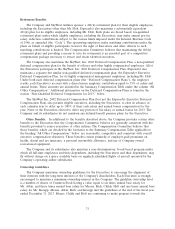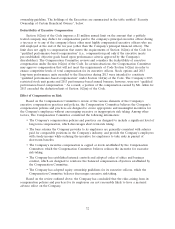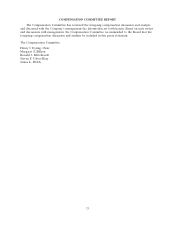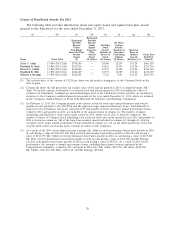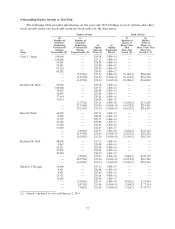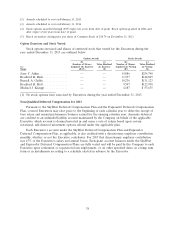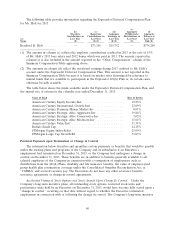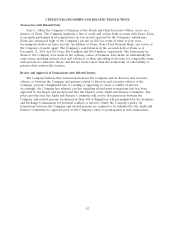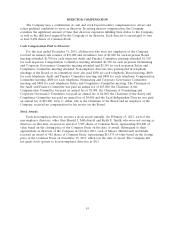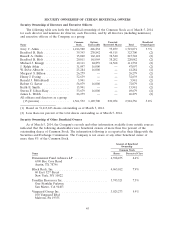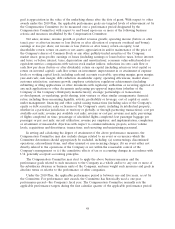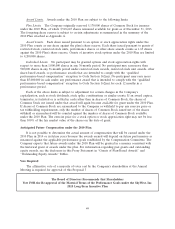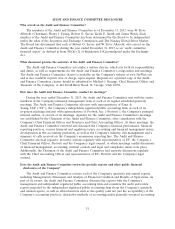SkyWest Airlines 2013 Annual Report Download - page 155
Download and view the complete annual report
Please find page 155 of the 2013 SkyWest Airlines annual report below. You can navigate through the pages in the report by either clicking on the pages listed below, or by using the keyword search tool below to find specific information within the annual report.
plans generally define a ‘‘change in control’’ as any of the following events: (i) the acquisition by any
person of 50% or more of the Company’s voting shares, (ii) replacement of a majority of the
Company’s directors within a two-year period under certain conditions, or (iii) shareholder approval of
a merger in which the Company is not the surviving entity, sale of substantially all of the Company’s
assets or liquidation. All shares of restricted stock previously issued under the Company’s 2006
Long-Term Incentive Plan and prior long-term incentive plans became fully vested prior to 2013;
accordingly, a change in control of the Company in 2013 would not have accelerated the vesting of
such restricted stock.
The following table shows for each Executive the intrinsic value of his unvested stock options,
unvested restricted stock units and performance units payable in cash, as of December 31, 2013, that
would have been accelerated had a change in control of the Company occurred on that date, calculated
in the case of restricted stock units and stock options, by multiplying the number of underlying shares
by the closing price of the Common Stock on the last trading day of 2013 ($14.79 per share) and, in
the case of stock options, by then subtracting the applicable option exercise price:
Early Vesting Early Vesting of Early Vesting of
Name of Stock Options Restricted Stock Units Performance Units
Jerry C. Atkin ............ $136,635 $1,003,457 $785,795
Bradford R. Rich .......... $ 87,487 $ 602,086 $488,186
Russell A. Childs .......... $ 74,465 $ 509,811 $413,199
Bradford R. Holt .......... $ 73,885 $ 509,797 $413,199
Michael J. Kraupp ......... $ 26,618 $ 216,141 $175,023
If a change in control with respect to the Company results in acceleration of vesting of an
Executive’s otherwise unvested stock options, unvested restricted stock units or performance unit
awards payable in cash, and if the value of such acceleration equals or exceeds three times the
Executive’s average W-2 compensation with the Company for the five taxable years preceding the year
of the change in control (the ‘‘Base Period Amount’’), the acceleration would result in an excess
parachute payment under Code Section 280G. An Executive would be subject to a 20% excise tax on
any such parachute payment in excess of the Base Period Amount, and the Company would be unable
to deduct the amount of the parachute payment in excess of the Base Period Amount for tax purposes.
The Company has not agreed to provide its Executives with any gross-up or reimbursement for excise
taxes imposed on excess parachute payments.
Deferred Compensation. If the employment of an Executive were terminated on December 31,
2013, the Executive would have become entitled to receive the balance in his account under the
applicable deferred compensation plan. Distribution would be made in the form of a lump sum or in
installments, and in accordance with the distributions schedule elected by the Executive under the
applicable plan. The 2013 year-end account balances under those plans are shown in column (e) in the
applicable Non-qualified Deferred Compensation Tables set forth above. An Executive’s account
balance would continue to be credited with notational investment earnings or losses through the date of
actual distribution.
41


